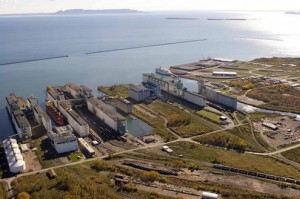 THUNDER BAY – At first glance, comparing Hamilton and Thunder Bay seems inappropriate given that Hamilton has nearly five times the population of Thunder Bay and is located in the highly urbanized south of Ontario. Yet, for comparison purposes it would be difficult to find a resource manufacturing/port city of 100,000 in southern Ontario that is an eight hour drive from any other major Canadian urban centre. However, they are both “Lakeheads” with Thunder Bay and its port at the head of Lake Superior and Hamilton at the Head of Lake Ontario. Both have served as transshipment points to their respective hinterlands and both developed into major industrial centers – Hamilton with steel and Thunder Bay with rail car manufacturing and forest products. As well, both have been hard hit by the economic change of the last decade and the decline of manufacturing and have been trying to diversify their economies.
THUNDER BAY – At first glance, comparing Hamilton and Thunder Bay seems inappropriate given that Hamilton has nearly five times the population of Thunder Bay and is located in the highly urbanized south of Ontario. Yet, for comparison purposes it would be difficult to find a resource manufacturing/port city of 100,000 in southern Ontario that is an eight hour drive from any other major Canadian urban centre. However, they are both “Lakeheads” with Thunder Bay and its port at the head of Lake Superior and Hamilton at the Head of Lake Ontario. Both have served as transshipment points to their respective hinterlands and both developed into major industrial centers – Hamilton with steel and Thunder Bay with rail car manufacturing and forest products. As well, both have been hard hit by the economic change of the last decade and the decline of manufacturing and have been trying to diversify their economies.
According to the 2010 BMA Municipal Study, Hamilton has 530,420 people while Thunder Bay has only 110,984. Over the period 2006-09, Hamilton’s population grew by 5.1 percent while Thunder Bay’s grew by only 1.7 percent. Hamilton is more densely populated but also still quite spread out. Though it has nearly five times the population, its population density is 475 people per square kilometer while Thunder Bay’s is 338. Interestingly enough, while Hamilton has five times the population, it only has about three times the length of paved roadways indicating the relatively higher dispersion of Thunder Bay’s urban setting.
Hamilton is the older of the two cities, dating back to the early 19th century with city status for Port Arthur and Fort William – Thunder Bay’s predecessors – going back to the early 20th century. Yet, Thunder Bay has a higher proportion of its homes erected before 1986 reflecting slower housing development over the last few decades. Hamilton has benefitted from being closer to the GTA when it comes to housing growth over the last few decades. Household income is also higher in Hamilton compared to Thunder Bay – at 78,000 dollars versus 69,000.
While both cities have been subjected to the trauma of manufacturing decline, the economic indicators suggest that Hamilton has weathered the downturn relatively better than Thunder Bay. Per capita building permit values in Hamilton are double those of Thunder Bay, household incomes are higher and population growth faster. This is also apparent when some of the municipal government indicators are examined. Per capita tax assessments have grown faster in Hamilton than Thunder Bay. The per capita municipal financial position for Hamilton is better than Thunder Bay, according to the BMA study, and the debt reserve ratio is 0.8 for Hamilton and 2 for Thunder Bay. In terms of the impact on municipal fiscal position, Thunder Bay has fared comparatively worse.
One explanation for Thunder Bay’s poorer performance might lie in its municipal tax structure. Thunder Bay’s net municipal levy per capita currently stands at 1,319 dollars while Hamilton’s is only 1,269 dollars. However, taxes per detached bungalow on average are higher in Hamilton (though so are property values) as are standard industrial taxes per square foot as well as rates for things like neighborhood retail. Tax differentials are not sufficient to explain the difference in recent growth and activity. Location is probably a more important factor. There is simply a much larger population cluster surrounding Hamilton – both in Canada and the United States – providing it with economic opportunities that Thunder Bay can only dream of.
Thunder Bay is still a small isolated population island that needs to overcome locational disadvantages despite its location in the middle of the country. While Thunder Bay may be in the centre of the country’s east-west axis, unfortunately there are not a couple of million people to go along with it. Once again, it is the market depth of a larger population that provides much of southern Ontario with long-term economic growth opportunities as well as competitive pressure. Thunder Bay needs to focus new energy on how to boost its immediate urban as well as regional population if it is to grow in the long term. While population growth and associated congestion may seem to be drawbacks in southern Ontario, they also come with the opportunity that creates jobs and retains youth.
Livio Di Matteo
 Livio Di Matteo is an economist in Thunder Bay, Ontario specializing in public policy, health economics, public finance and economic history. Livio Di Matteo is a graduate of the Fort William Collegiate Institute (1898-2005) whose school motto “Agimus Meliora” has served as a personal inspiration. Livio Di Matteo holds a PhD from McMaster University, an MA from the University of Western Ontario and an Honours BA from Lakehead University. He is Professor of Economics at Lakehead University where he has served since 1990. His research has explored the sustainability of provincial government health spending, historical wealth and asset holding and economic performance and institutions in Northwestern Ontario and the central North American economic region. His historical wealth research using census-linked probate records is funded by grants from the Social Sciences and Humanities Research Council of Canada. He has constructed, assembled and analyzed nearly 12,000 estate files for Ontario over the period 1870 to 1930. Livio Di Matteo writes and comments on public policy and his articles have appeared in the National Post, Toronto Star, the Winnipeg Free Press and Thunder Bay Chronicle-Journal and NetNewsledger.com. Livio Di Matteo has had an entry in Canadian Who’s Who since 1995.
Livio Di Matteo is an economist in Thunder Bay, Ontario specializing in public policy, health economics, public finance and economic history. Livio Di Matteo is a graduate of the Fort William Collegiate Institute (1898-2005) whose school motto “Agimus Meliora” has served as a personal inspiration. Livio Di Matteo holds a PhD from McMaster University, an MA from the University of Western Ontario and an Honours BA from Lakehead University. He is Professor of Economics at Lakehead University where he has served since 1990. His research has explored the sustainability of provincial government health spending, historical wealth and asset holding and economic performance and institutions in Northwestern Ontario and the central North American economic region. His historical wealth research using census-linked probate records is funded by grants from the Social Sciences and Humanities Research Council of Canada. He has constructed, assembled and analyzed nearly 12,000 estate files for Ontario over the period 1870 to 1930. Livio Di Matteo writes and comments on public policy and his articles have appeared in the National Post, Toronto Star, the Winnipeg Free Press and Thunder Bay Chronicle-Journal and NetNewsledger.com. Livio Di Matteo has had an entry in Canadian Who’s Who since 1995.
This article was originally posted on Livio Di Matteo’s NORTHERN ECONOMIST Blog at http://ldimatte.shawwebspace.ca.






